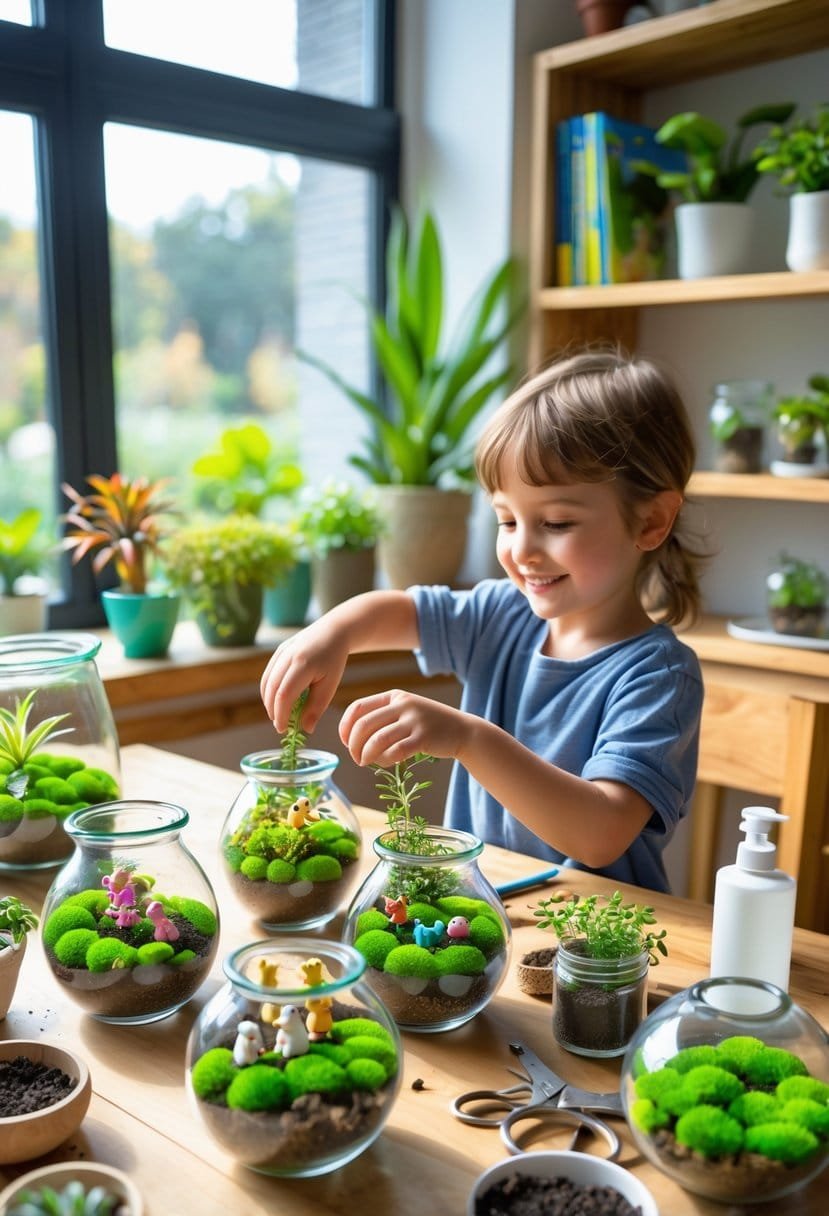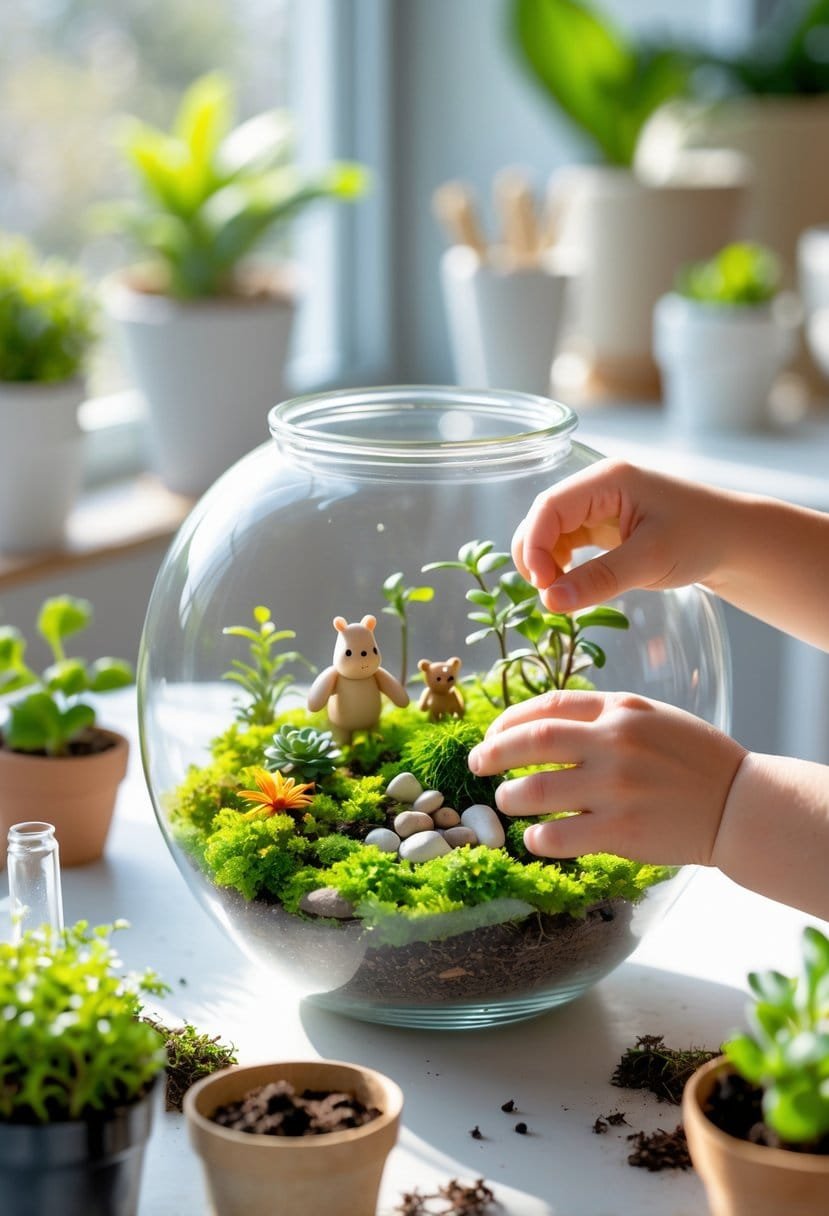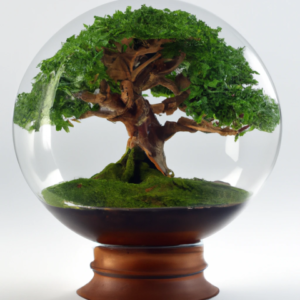When my daughter first spotted a tiny plastic dinosaur peeking through fern leaves in a glass bowl at our local coffee shop, her eyes lit up with wonder.
That simple terrarium sparked weeks of questions about how plants grow and what makes tiny ecosystems thrive.
Kid-friendly terrarium ideas offer hands-on learning and creative fun. They help children learn about plant care, ecosystems, and responsibility as they build their own miniature gardens.

Kids enjoy making terrariums as a craft![]() because each step is exciting.
because each step is exciting.
Children stay engaged as they choose colorful gravel, pick plants, and arrange tiny figurines in their glass home.
The project suits different ages and skill levels. Families and classrooms can enjoy this activity together.
Terrariums turn abstract science concepts into real experiences. Kids can watch the water cycle, see roots grow, and learn why plants need certain conditions.
These miniature ecosystems teach children about the natural world![]() and give them a sense of accomplishment as they care for their living creation.
and give them a sense of accomplishment as they care for their living creation.
Key Takeaways
- Terrariums blend creativity and science, teaching kids about plant care and ecosystems through hands-on activities.
- Basic supplies like glass containers, gravel, soil, and small plants make terrarium creation easy and affordable.
- Regular maintenance helps kids develop responsibility as they watch their miniature garden grow.
What Is a Terrarium?

A terrarium is a [miniature garden
Layering Materials Properly
I always clean the glass container and all materials with soap and water. This step removes harmful chemicals and bacteria that could hurt your plants.
I start with the drainage layer. I add one inch of clean pebbles or gravel to the bottom of the container.
I never pour the material directly. Instead, I scoop it in handfuls to prevent cracking the glass.
Next, I add two to three inches of tropical soil mix. Regular potting soil compacts too quickly in terrariums.
The soil depth depends on your plant’s root size.
Materials needed:
- Glass container with lid
- Pebbles or gravel for drainage
- Tropical soil mix
- Spray bottle
If you want to add decorative items like rocks or figurines, place them now before planting. This anchors them into the soil.
Planting and Arranging Small Plants
I choose tropical plants that enjoy high humidity![]() and bright indirect light. Succulents and cacti do not survive in sealed terrariums.
and bright indirect light. Succulents and cacti do not survive in sealed terrariums.
I use a spoon to create small holes in the soil for each plant’s roots. This protects delicate root systems.
I place the largest plants first. Then I fill in with smaller ones.
The arrangement looks best when balanced from all angles.
Plant placement tips:
- Tall plants go in the back
- Short plants stay in front
- Leave space between plants for growth
A paintbrush helps me dust off leaves and move soil in tight spaces. I keep decorative elements simple so the plants stand out.
The plants need room to grow, so I avoid overcrowding the container. Three to four small plants work well in most containers.
Watering and Sealing the Terrarium
I spray the entire terrarium until the topsoil looks wet but the bottom soil stays dry. I never pour water directly into the container to avoid waterlogging.
The water cycle inside the terrarium spreads moisture evenly. I look for condensation on the glass walls as a good sign.
I seal the container with its lid to trap humidity and heat. This creates the closed ecosystem that helps terrariums thrive.
Watering checklist:
- Top soil: moist and dark
- Bottom soil: dry looking
- Glass walls: light condensation
- No standing water in drainage layer
If I see too much condensation, I remove the lid for a few hours. The terrarium maintains its own water cycle![]() once balanced.
once balanced.
Best Plants for Kid-Friendly Terrariums
Choosing the right plants helps create a successful terrarium project with children. The best options are small plants that thrive in humid environments and can handle occasional mistakes.
Moss Varieties
Moss works well for children’s terrariums because it’s hard to kill. I recommend starting with basic moss types you can find in your yard.
Club moss is one of my favorite choices for kids. It creates a carpet-like effect and needs cooler temperatures with low to moderate light![]() .
.
This crawling plant stays small and adds texture to any terrarium.
You can collect moss from shaded areas around your home. Look for bright green patches on rocks or tree bark.
Clean off any debris before placing it in the terrarium. Moss needs moist conditions but not soggy soil.
Kids can easily spray it with a water bottle when it looks dry. This teaches them about plant care with little risk.
Key benefits of moss for kids:
- Forgiving if overwatered
- Grows slowly and won’t outgrow the container quickly
- Adds a woodland feel
- Easy to find and collect
Ferns and Shade-Loving Plants
Ferns love the humid environment that glass containers create. I suggest choosing smaller varieties that stay compact.
Lemon Button Fern is easy to grow![]() . It grows up to 12-18 inches tall but starts small.
. It grows up to 12-18 inches tall but starts small.
Place it in bright indirect light and keep the soil damp.
Baby Tears creates a lovely ground cover effect. This low-growing plant is excellent in terrariums![]() and only grows up to 6 inches tall.
and only grows up to 6 inches tall.
Kids enjoy watching it spread and fill spaces.
Artillery Fern looks like a fern but is not one. It’s very easy to grow and reaches about 12 inches tall.
Keep the soil slightly moist and pinch back stems to keep it bushy.
These plants help kids learn about different leaf shapes and textures. They also show how plants adapt to shade.
Choosing the Right Succulents
Succulents work well for kids because they survive if watering gets forgotten. I recommend starting with hardy varieties.
Small jade plants are perfect for beginners. They have thick, waxy leaves that store water.
Kids can see how these plants differ from regular houseplants.
Hens and chicks produce baby plants that children find fascinating. They can watch new plants grow from the main plant.
These stay small and come in many colors.
Mini aloe plants are another great choice. They’re hard to kill and teach kids about plants that help with minor cuts and burns.
Tips for success with succulents:
- Use well-draining soil
- Water less frequently than other plants
- Provide bright light
- Choose small varieties
When kids place the succulents inside the jar![]() , let them decide where each plant goes. This gives them ownership and encourages care.
, let them decide where each plant goes. This gives them ownership and encourages care.
Educational Insights: Learning Opportunities
Building terrariums creates mini ecosystems![]() that show how water moves through plants and soil. Kids see how living things work together and how consistent care keeps systems healthy.
that show how water moves through plants and soil. Kids see how living things work together and how consistent care keeps systems healthy.
Children develop observation skills while watching their glass gardens change over time.
Observing the Water Cycle
Terrariums provide a clear view of how water moves through natural systems. Kids can watch condensation form on the glass walls as water evaporates from soil and plants.
The water droplets on the container show evaporation in action. Plants release water through their leaves, creating visible moisture.
Key water cycle stages:
- Evaporation from soil and plant leaves
- Water vapor rising in the container
Condensation forms on glass surfaces. Water droplets fall back to soil.
I encourage children to check their terrariums daily for these water signs. They can draw pictures or keep a simple journal.
The closed environment makes the water cycle easy to understand. Kids see the same water used again and again, just like in nature.
Understanding Ecosystem Interactions
Terrariums teach kids about ecosystems![]() by showing how plants, soil, water, and air interact in a small space. Each part depends on the others for balance.
by showing how plants, soil, water, and air interact in a small space. Each part depends on the others for balance.
Plants use carbon dioxide and release oxygen during the day. At night, this process
Keeping Terrariums Healthy
Proper placement and regular check-ups help terrariums stay healthy for months. I put mine in bright areas but never in direct sunlight.
Light Requirements:
- North or northeast-facing windows work best.
- Direct sun burns leaves, so I avoid it.
If leaves turn brown or yellow, I move the terrarium to a different spot.
Regular maintenance helps prevent most problems. I have kids pinch off dead flowers and brown leaves right away.
Monthly Tasks:
- Remove dead plant material.
- Wipe the glass clean with a damp cloth.
I check for overcrowding as plants grow.
I don’t fertilize unless the plants start turning yellow. When needed, I use fertilizer at one-fourth the recommended rate.
Too much fertilizer causes plants to grow too quickly and outgrow the container.
When plants get too tall, I teach kids to pinch new growth. This keeps plants small and encourages bushier growth.
Frequently Asked Questions
Parents often ask about plant safety and materials when starting terrarium projects. Here are answers to the most common questions about creating educational terrariums with children.
What are the best plants to use in a terrarium with children?
I recommend tropical plants that do well in high humidity for kid-friendly terrarium projects. Pothos and Philodendron work well because they’re hardy and easy to care for.
Moss is another great choice for children’s terrariums. You can even forage moss from your backyard if you have it.
Small ferns also thrive in terrarium conditions. They add interesting texture and stay compact.
I avoid using succulents or cacti in closed terrariums with kids. These plants do not survive well in humid terrariums.
How can you make a DIY terrarium that’s safe for kids?
I always supervise children during terrarium making because the process involves some hazardous items. Many tropical plants are toxic if eaten, so I watch closely.
I start by cleaning all materials with soap and water. This includes the glass container, lid, drainage materials, and decorations.
I use blunt tools like spoons for digging holes and paintbrushes for moving soil. Sharp tools are not needed for terrarium construction.
I teach kids to use spray bottles instead of pouring water. This prevents waterlogging and makes watering safer.
What materials are required to create a terrarium for a school project?
I use a glass container with a lid for any school terrarium project. If the container does not have a lid, I get a custom acrylic one.
The drainage layer needs pebbles, gravel, or leca balls. I add about one inch of drainage material at the bottom.
I use tropical soil mix instead of regular potting soil because it doesn’t compact as quickly. Two to three inches of soil is enough.
A spray bottle is important for watering. I also bring spoons and paintbrushes for planting and arranging.
Which terrarium kits are most suitable for children and beginners?
I recommend the Sugar Blush Studio kit for younger children because it includes non-toxic chia seeds and fun accessories like plastic unicorns. The seeds grow quickly and keep kids interested.
For older kids, I suggest the Beyond the Vine Terrariums dinosaur kit. It has higher quality materials and traditional terrarium plants, but some plants may be toxic if eaten.
Both kits include all necessary materials. This saves time compared to buying items separately.
I check that any kit has good drainage materials and the right soil. Some cheaper kits leave out these important parts.
How can a terrarium be utilized as an educational tool in the classroom?
I use terrariums to teach kids about ecosystems and water cycles. Children can watch how terrariums create small tropical ecosystems that sustain their own water cycle.
The project combines science and art, making it great for hands-on learning. Kids learn about plant selection, substrate choices, and care.
I have students watch videos about terrarium basics before starting. This helps them understand the science behind the project.
Ongoing care teaches responsibility. Students can observe plant growth and learn proper watering techniques.
What are the steps to create a mason jar terrarium suitable for kids?
Start by cleaning the mason jar and lid thoroughly with soap and water. Clean all materials to prevent harmful microbes.
Add one inch of drainage material like small pebbles or gravel. Scoop it in by handfuls rather than pouring to avoid cracking the glass.
Add two to three inches of tropical soil mix. Place any large decorative items before planting.
Use a spoon to make small holes for plant roots. After planting, spray the soil until the top looks wet but the bottom stays dry.
Seal the jar with the lid to create a humid environment. Over time, the terrarium balances its own moisture levels.
